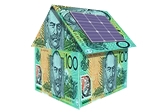
One of the best reasons to own a solar panel system is that it’ll eventually pay itself off thanks to electricity bill savings. Find out how to calculate how long this will take.

Working out how long it will be before a solar panel array repays its own purchase costs through energy savings is a seriously complicated affair. There are many different factors that play into the final figure. Some things (like billing costs) will change significantly (and unpredictably) over time, altering your calculations. Any formula devised for working out the repayment time will need to take the following things into consideration:
Initial outlay
This is the money you spend upfront on the system – the panels, framing, wiring, inverter, meter, battery bank, charge controller and installation costs will all contribute to this. When you’re buying a complete kit this is usually represented as a single, all-inclusive figure, which can range from anywhere between $5,000 to $30,000. If you’ve got the patience and know-how you may be able to save money by buying the components separately, though this may cause problems with installation if you don’t choose carefully.
The initial outlay for the solar panels represents the money you’re trying to make back with energy saved and energy generated. The more you spend on your initial investment, the longer it will take to pay itself back. For that reason it’s a good idea to shop around for a system that gives you the best bang for your buck.
Electricity savings
Once everything’s up and running, you can begin to recoup some of the costs from the initial outlay. How much you’re saving on energy costs will depend on how much power your system is capable of generating each year, stacked against your total power consumption for a year.
The average Australian household uses 18 kilowatt hours (kWh) of electricity per day. If your household’s usage is at the average, and your solar setup generates 9kWh per day on average, you generate 50% of your yearly usage, and can expect to see that level of reduction in your power bills. Since electricity prices are likely to rise, this reduction will become exponentially more valuable. Obviously the more of your consumption you can account for with solar (and the less electricity you use in general), the better!
How do feed-in tariffs work?
Feed-in tariffs (FiTs) are a state-based incentive for people with solar panels to feed electricity back into the grid. If you’re generating more power than you use, in certain states you can be paid for the additional power your system puts back into the electricity grid. Though many states once had FiTs, some have now dispensed with them and are not accepting new applications. Before you factor in money being paid to you from your power company for the energy you create, check your state’s sustainability website for more information on if (and how) FiTs apply in your area. Feed-in tariffs can make a big difference to your payback time.
There is talk of a Federal FiT scheme, but as yet nothing’s been set in stone.
How rebates affect the equation
The biggest reduction to your initial outlay will come in the form of Federal rebates. The exact amount of money you will receive back from the government for purchasing a PV system will be determined by how much power it’s expected to generate and where in Australia you live. Larger power systems will be eligible for a larger discount, though this is also offset by a higher initial outlay price. Areas of Australia with more available sunlight will have a higher threshold for rebates since the potential for energy gain is higher.
The rebates take the form of solar credits, which are almost always calculated by your PV system supplier and offered as a discount on the purchase price of the system. This removes much of the complicated paperwork involved in claiming the credits, though if you choose to you can apply for your own solar credits.
Replacement costs
As well as the obvious initial outlay, you’ll also need to take into account that over time, your solar panels will become less effective. How much they degrade will depend on the model you buy, of course – check with the supplier or manufacturer on how effective the solar panels will be over the course of their life.
Certain parts may also fail or need to be repaired over time. Most inverters, in particular, are rated to work for between 10 and 15 years (some will be more resilient than others). When factoring in the cost of a replacement inverter, it’s worth considering that they’re likely to be a fair bit cheaper in ten years from now too. Just how much cheaper is hard to say – this will depend on new technologies, and the volumes in which they’re likely to be produced further down the track.
Deep-cycle batteries have a limited lifespan as well. These differ vastly in terms of how long they’re expected to last, and may give you good use from anywhere between five and 20 years. Again, the cost of replacement batteries is likely to change significantly as newer technologies appear on the market.
It’s not a sensible idea (or a responsible one) to gamble on the fact that there will be cheaper or better gear available in a decade, obviously. Where possible you should choose hardware that’s going to serve your needs for as long as possible.
Payback time estimates
Below is a table showing some estimated payback times for a solar panel installation (based on figures from the ATA, October 2013):
| Payback times (in years) by export percentage | |||||
|---|---|---|---|---|---|
| Location | 10% |
25% | 50% | 75% | 90% |
| Brisbane | 5 years | 5 | 7 | 11 | 18 |
| Regional QLD | 4 | 5 | 6 | 10 | 15 |
| Sydney | 5 | 6 | 8 | 13 | 21 |
| Regional NSW | 5 | 5 | 7 | 11 | 17 |
| ACT | 5 | 6 | 8 | 12 | 21 |
| Melbourne | 6 | 6 | 9 | 14 | 24 |
| Regional Vic | 5 | 5 | 7 | 11 | 17 |
| Hobart | 6 | 6 | 9 | 14 | 24 |
| Regional Tas | 5 | 6 | 8 | 13 | 22 |
| Adelaide | 5 | 5 | 7 | 10 | 13 |
| Regional SA | 4 | 5 | 6 | 9 | 12 |
| Perth | 5 | 5 | 7 | 11 | 16 |
| Regional WA | 4 | 5 | 6 | 9 | 14 |
| Darwin | 5 | 5 | 5 | 5 | 5 |
| Regional NT | 5 | 5 | 5 | 5 | 5 |
| ‘Export’ means the percentage of the energy your solar setup produces which is ‘exported’ back into the electricity grid.
Tables and figures courtesy of the Alternative Energy Association. A full description of the assumptions and calculations for the figures provided above is available on the ATA website.
|
|||||





